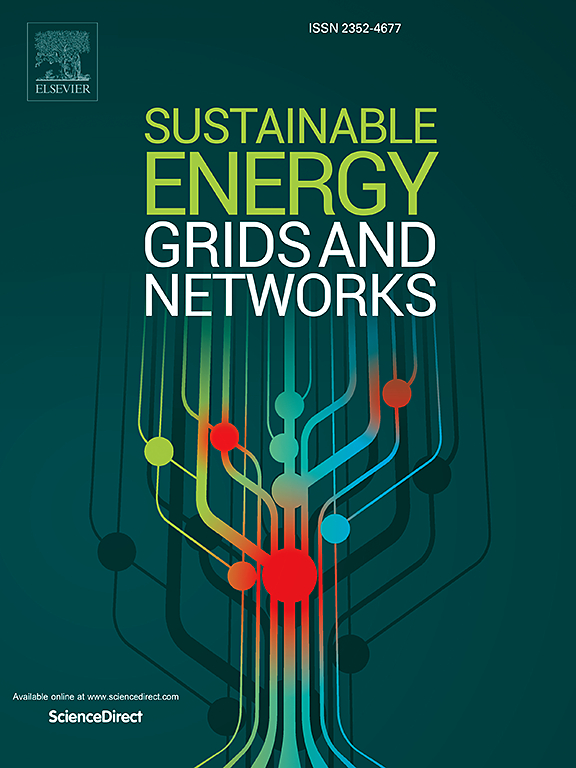A method for configuring hybrid electrolyzers based on joint wind and photovoltaic power generation modeling using copula functions
IF 4.8
2区 工程技术
Q2 ENERGY & FUELS
引用次数: 0
Abstract
Considering the specific wind and photovoltaic power characteristics of a certain region, this study investigates the optimal ratio of Alkaline Electrolysis Cells (AEL) to Proton Exchange Membrane (PEM) electrolyzers in a hybrid electrolysis system for hydrogen production. A flexible model for configuring the hybrid electrolysis system is proposed, based on a copula function for joint wind and solar power modeling. This model generates wind and photovoltaic power generation scenarios using the copula function, incorporating a selection mechanism to ensure that the output scenarios are more representative of the actual data characteristics of wind and photovoltaic power output. Consequently, considering both the fluctuation and amplitude, the wind and photovoltaic power data are decomposed using the Ensemble empirical mode decomposition method. The decomposed components are then allocated to the two types of electrolyzers. Furthermore, the optimal configuration of the hybrid electrolysis system is determined by minimizing the costs associated with wasted power, electricity purchases, and other expenses. Finally, a case study of a 100 MW wind farm and a 50 MW photovoltaic power station in Northwest China is presented, concluding that the optimal configuration ratio of AEL to PEM electrolyzers is 2:1. In a Matlab/Simulink platform, the performance metrics of the hybrid electrolysis system were validated. It was found that the hydrogen production rate of the hybrid electrolyzer is comparable to that of the PEM electrolyzer, but with a lower required cost. Additionally, the hydrogen production rate and volume of the optimal configuration for the hybrid electrolyzer determined by the model proposed in this paper are higher than those obtained through the optimization algorithm's optimal configuration.
基于使用 copula 函数的风力和光伏联合发电建模的混合电解槽配置方法
考虑到某一地区特定的风能和光伏发电特性,本研究探讨了制氢混合电解系统中碱性电解槽(AEL)与质子交换膜(PEM)电解槽的最佳比例。基于风能和太阳能联合建模的 copula 函数,提出了一个用于配置混合电解系统的灵活模型。该模型利用 copula 函数生成风力和光伏发电情景,并结合了选择机制,以确保输出情景更能代表风力和光伏发电输出的实际数据特征。因此,考虑到波动性和振幅,使用集合经验模式分解法对风电和光伏发电数据进行分解。然后将分解后的组件分配给两种类型的电解槽。此外,混合电解系统的最佳配置是通过最大限度地降低与浪费电力、电力采购和其他费用相关的成本来确定的。最后,通过对中国西北地区一个 100 兆瓦风电场和一个 50 兆瓦光伏电站的案例研究,得出 AEL 与 PEM 电解槽的最佳配置比例为 2:1。在 Matlab/Simulink 平台上,对混合电解系统的性能指标进行了验证。结果发现,混合电解槽的制氢率与 PEM 电解槽相当,但所需成本更低。此外,本文提出的模型确定的混合电解槽最佳配置的制氢率和体积均高于优化算法最佳配置的制氢率和体积。
本文章由计算机程序翻译,如有差异,请以英文原文为准。
求助全文
约1分钟内获得全文
求助全文
来源期刊

Sustainable Energy Grids & Networks
Energy-Energy Engineering and Power Technology
CiteScore
7.90
自引率
13.00%
发文量
206
审稿时长
49 days
期刊介绍:
Sustainable Energy, Grids and Networks (SEGAN)is an international peer-reviewed publication for theoretical and applied research dealing with energy, information grids and power networks, including smart grids from super to micro grid scales. SEGAN welcomes papers describing fundamental advances in mathematical, statistical or computational methods with application to power and energy systems, as well as papers on applications, computation and modeling in the areas of electrical and energy systems with coupled information and communication technologies.
 求助内容:
求助内容: 应助结果提醒方式:
应助结果提醒方式:


